Service: Mechanical Engineering
General Electric
Brilliant Factory
General Electric’s new state-of-the-art gas engine plant is one of the most advanced in GE’s global operations and the first of its kind in Canada. “It’s a plant that is reimagining how we manufacture. It incorporates all the concepts of lean: speed with excellent quality — coupled with everything that is now available and that is coming down the pipe in digital technology, with the latest in software developments.”*
— Elyse Allan, GE Canada CEO
HH Angus provided mechanical, electrical, plumbing, security, IT, lighting and vertical transportation consulting. The multi-modal plant, now owned by Advent International, manufactures gas engines that are coupled with either air or gas compressors, or with electric generators. The engines are distributed worldwide, primarily outside North America, in the oil and gas industry.
The plant runs three-dimensional machining simulations for CNC programs, gains real-time analytics to better understand the operating conditions of a machine or a test cell, operates lights-out machining, and combines all with advanced lean manufacturing practices.
Our IMIT scope included flexible structured cabling systems and supporting infrastructure, consisting of the latest shielded copper and fiber technologies, providing a transport platform for data, voice, video and other IP-based systems.
We also provided design for all low voltage technology systems. The factory uses equipment and machines embedded with sensors and connected to the high availability Industrial Internet Protocol-based network. Equipment data is streamed over secure links to the cloud for analysis.
Extensive design and installation of multiple audiovisual systems facilitate collaboration between global sites. Plant cabling design was provided per the most recent Industrial Premises standard. Working closely with the client’s IT, Security and AV groups, network-based systems were designed to the latest technology.
Our Angus Connect team was also involved in determining the performance requirements of client systems, product selection, preparation of working drawings and specifications, tender preparation and response evaluation.
SERVICES
Mechanical Engineering | Electrical Engineering | Security and IMIT Design | Vertical Transportation Consulting | Lighting Design
PROJECT FEATURES
Size: 450,000 ft2 | Status: Completed 2018
LOCATION
Welland, Ontario
KEY SCOPE ELEMENTS
Multi-model plant | Plant is fully air-conditioned to prevent "flash rust" | real-time analytics | Transport platform for data, voice, video and other IP-based systems | AV systems enable collaboration between global sites | Test cell scope added later | Met aggressive schedule for working drawings | LEED Silver Certified
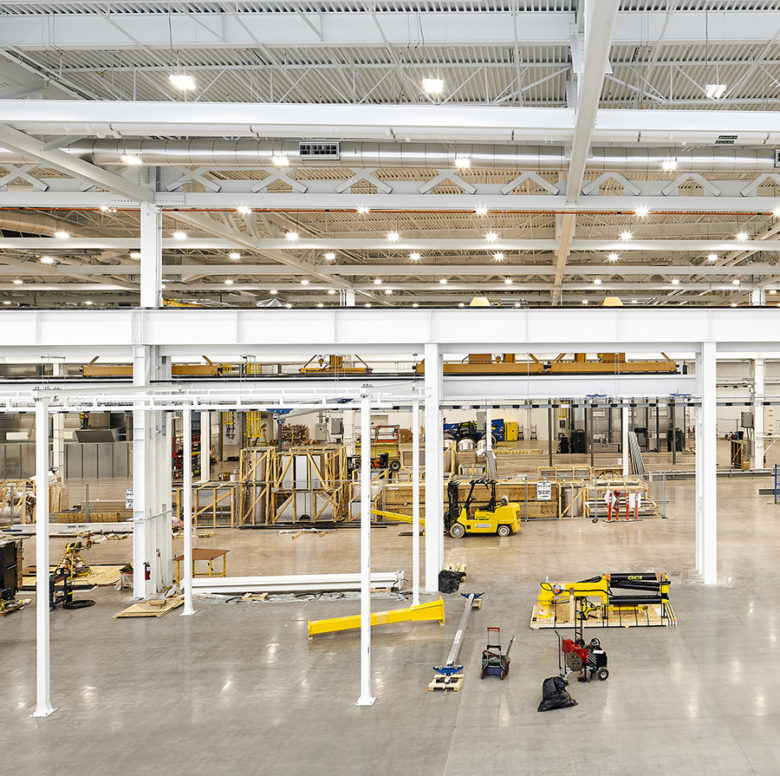
Custom HVAC control
The plant is fully air-conditioned to prevent ‘flash rust’, which can occur during machining of items such as crankshafts and connecting rods if humidity levels are not carefully controlled.
Industrial and support spaces
In addition to the main assembly and machine areas, three test cells, warehouse space, and paint areas, the plant also features front of house spaces such as offices, staff support, fitness centre, customer areas, hoteling for visiting customers and GE staff, conference rooms, etc.

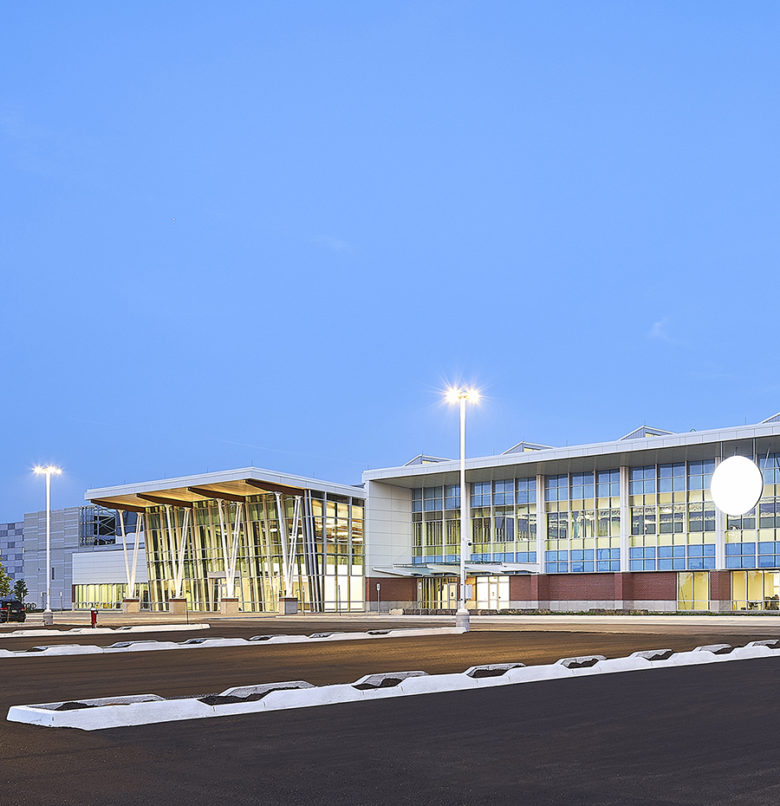
Expanding our scope
HH Angus’ project scope was increased to include the physical design of a significant new Test Cell addition to the plant, and to ensure Canadian compliance. The three test cells are connected to the main plant for testing engines prior to delivery. We met an aggressive schedule to produce working drawings for tender.
Toronto Sunnybrook Regional Cancer Clinic
HH Angus has been providing mechanical and electrical engineering at the Sunnybrook campus since 1945. The complex now totals more than 2,000,000 ft2. In that time, a great many individual projects have been successfully delivered. The Cancer Centre, described below, represents an ongoing program of redevelopment and renovation. Other large project examples from Sunnybrook include M Wing and the Sunnybrook High Voltage Emergency Power Renewal.
Toronto Sunnybrook Regional Cancer Clinic
The Cancer Centre at the Sunnybrook campus has been upgraded, renovated and expanded a number of times since originally constructed over 40 years ago. We have been involved with this facility since its inception. The original building was 70,000 ft2, with four Radiation Therapy Treatment Rooms and one Simulation Suite for treatment planning.
The facility saw a major expansion and renovation in the early 1990s, which increased the area to 200,000 ft2 and included eight new Radiation Therapy Treatment Rooms and two new Simulator Suites. An on-going program of upgrades has seen comprehensive replacement of older treatment equipment with newer options.
The original building construction included one simulator suite, two high energy (25MEV) radiotherapy treatment rooms, one medium energy (6 MEV) radiotherapy treatment room, one cobalt room and full chemotherapy facilities. Later, a second cobalt room was added, along with a building addition, including one medium energy (6MEV) radiotherapy treatment room and two simulators.
In 1993, a major addition included three medium energy (6MEV) radiotherapy treatment rooms (Siemens), a Simulator suite (Philips), three high energy (25 MEV) radiotherapy treatment rooms (Philips), a CT simulator suite (Picker), one new cobalt room, and relocation of the existing cobalt room.
In a renovation project in 1999/2000, we replaced existing treatment equipment, specifically two medium and two high energy radiotherapy treatment rooms (Siemens), and added a new high energy radiotherapy treatment room. That was followed a few years later by replacement of the existing cobalt treatment equipment with new medium energy radiation therapy equipment.
SERVICES
Mechanical Engineering | Electrical Engineering
PROJECT FEATURES
Size: 200,000 ft2 | Status: Ongoing Upgrades
LOCATION
Toronto, Ontario
KEY SCOPE ELEMENTS
Ongoing expansion and renovations
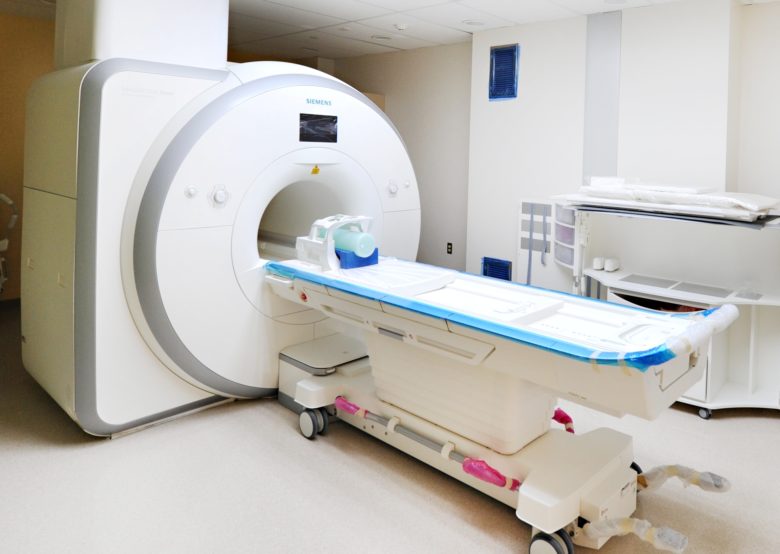
Increasing treatment options
In the decade from 2000 to 2010, we added a PET simulator, an MRI Suite, replaced one cobalt treatment room with a tomotherapy treatment room and, tackling one room at a time, have replaced all existing equipment.
Improving service
We also completed a renovation to modernize the Main Reception area and new Pharmacy, and renovations to the chemotherapy treatment area.

University of Toronto
Leslie L. Dan Faculty of Pharmacy
Canada’s largest pharmacy school, this 167,000 ft2 teaching and research facility includes practice laboratories, research facilities, a resource centre, lecture theatres and offices for faculty, staff and graduate students. The building is 16 storeys (13 above and three below grade), and supports the academic, research and teaching needs of more than 1,300 people daily.
A ‘repeatable’ environment is fundamental in research facilities. By designing steady and stable environmental conditions, experiments can be repeated without data corruption.
Program space includes 23 labs for pharmaceutical research. Laboratory features include distribution of lab gases, on-site nitrogen generation, Type II Reverse Osmosis water, and a ganged fume hood system sized to accommodate 65 fume hoods, complete with variable volume control and glycol heat recovery systems.
Conservation measures were applied to the laboratory systems to minimize energy use while meeting stringent laboratory standards. Separate plumbing systems were designed to avoid contamination by lab waste and to collect rainwater for distribution to the Winter Garden.
Signature ‘floating’ pods anchor the lighting design for the building’s dramatic five-storey atrium. Theatre-inspired lighting is computer controlled by a dimming system that changes the evening lighting every 15 minutes. Rather than attach luminaires to the pods themselves, which would have compromised the architect’s vision, the dramatic lighting comes from 128 – 375 watt and 300 watt quartz halogen lamps attached to black theatre pipes mounted on the vertical mullions. The fixtures can be moved up or down and become part of the spatial experience.
A 12-storey central atrium brings sunlight deep into the core in other parts of the building. For the upper perimeter, a high window system enables less expensive, concealed wall-wash lighting. Echoing the geometry of the interior architecture, LEDs were fixed into the handrails of hallways and bridges for emergency lighting.
SERVICES
Mechanical Engineering | Electrical Engineering | Lighting Design
PROJECT FEATURES
Size: 167,000 ft2 | Status: Completed 2006
LOCATION
Toronto, Ontario
KEY SCOPE ELEMENTS
23 labs for pharmaceutical reserch | Practice laboratories, research facilities, resource centre, lecture theatres, and offices for faculty, staff and graduate students | Signature floating pods lighting design | Energy conservation measures implemented | 12 storey atrium
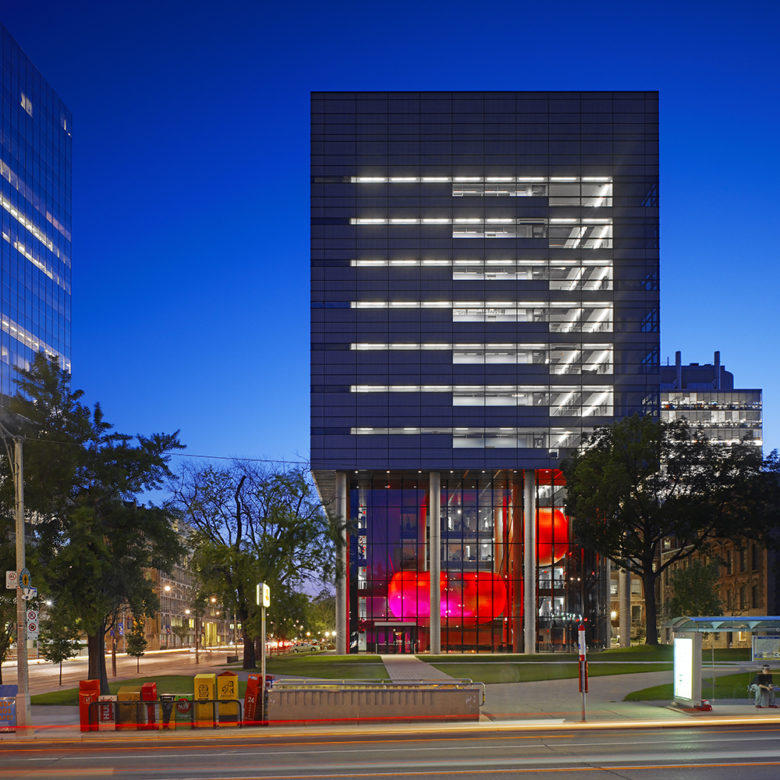
Designed for flexibility
As with all research centres, we design for future uses of the space. We plan for flexibility, to allow for future IT development, or to enable the space to be retrofitted quickly and cost-effectively.
Award-winning lighting
The Pharmacy Building has been honoured with numerous international awards and press coverage and, in 2009, the Toronto Star newspaper named the Leslie Dan lighted pods as one of “175 Reasons to Love Toronto”. At dusk, the pods mimic the setting sun, bursting with fiery reds and deep blues. Colours advance through a palette of hues, starting on one pod and flowing to the other.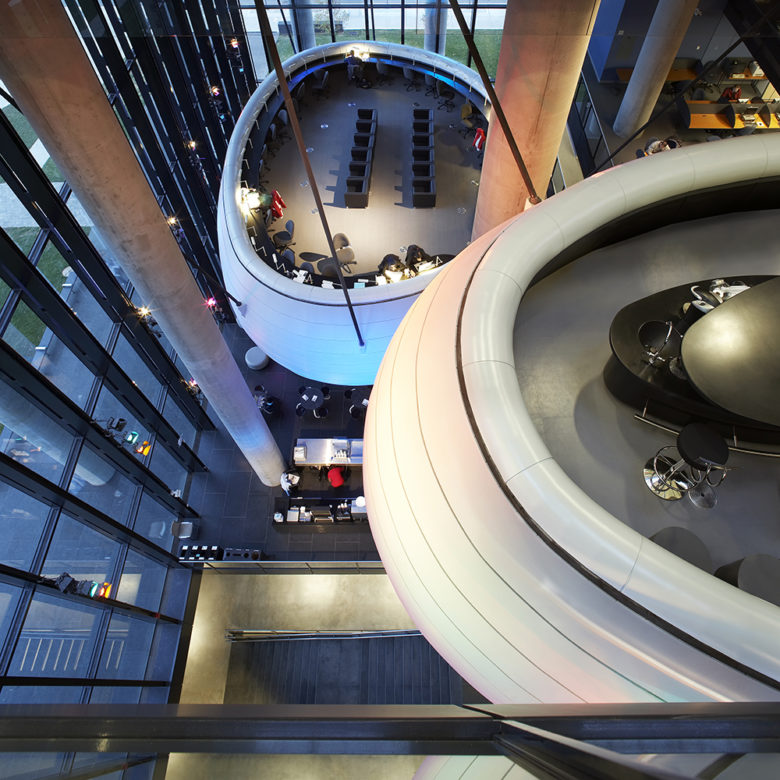
Ernst & Young
100 Adelaide Tower, Multi-Floor Fitout
“Throughout the tower...elements of wellness enhance the EY experience for employees, including quiet spaces for recharging, changing rooms for getting ready on the go, showers, bike parking and more.”
– EY@Work
The downtown Ernst & Young (EY) Tower is Toronto’s first Triple A office building constructed to LEED Platinum standards. The 255,000 ft2 tenant project was an 11-floor fitout designed to be the epitome of the modern flexible work environment, to reflect EY’s new ‘Workplace of the Future’. Amenities include tech-enabled boardrooms, collaborative meeting areas, a dynamic event space and EY Toronto’s Innovation Centre. The building has received Toronto’s second WELL Gold certification. (HH Angus is proud to have been involved in both of these WELL Gold-certified projects).
Features of the project include a new interconnecting stairway between two floors; a café/hub, IT equipment room, and Main Communications Room on each floor; Reception and client-facing floor; intricate lighting design with high-end luminaires, requiring complex design coordination by the lighting team; new guest washrooms; catering kitchen; a conference floor with the design intent that spaces be multipurpose; executive suite; training facility; mail room; office services; and IT on-site services.
SERVICES
Mechanical Engineering | Electrical Engineering | Lighting Design
PROJECT FEATURES
Size: 255,000 ft2 | Status: Completed 2018
LOCATION
Toronto, Ontario
KEY SCOPE ELEMENTS
Toronto's first Triple A office building constructed to and certified LEED Platinum | WELL Gold certified | Intricate lighting design | Flexible work spaces
Billy Bishop Toronto City Airport
Expanded Air Terminal Building
When the new 150,000 ft2 terminal first opened to the public in 2010, the airline expected to almost double the number of passengers from the year before. Phase Two included 10 bridged aircraft gates and two additional passenger lounges. The terminal includes a mix of retail, food services, duty-free, car rentals and other amenities.
The large arrivals hall area, along with the increasing number of people using it, required a specialized heat recovery system. HH Angus designed a high efficiency enthalpy heat wheel system using outdoor air supply.
Among the benefits of this heat recovery system are reduced operating costs from recovering heat that would otherwise be lost by venting to the outside. In turn, this allows for a reduction in the size and capacity needed for the heating and cooling plant that serves the system.
An exterior sprinkler system for the apron area was included in our mechanical design. This system protects building occupants in the event of a jet fuel fire on the tarmac.
Some of the interesting design challenges on this project included the integration of the sanitary sewage system with the existing Terminal system. The Toronto Islands site has no gravity drainage and requires a pumping system for sanitary sewage. Also, the site is a live airport operation, which presented unique challenges regarding phasing of services.
Our elevator system designs responded to user needs for accessibility, safety, reliability and operational efficiency. Based on anticipated traffic numbers, plus luggage, a single large roped-hydraulic elevator (2,270 kgs) serves travelers in the corridor leading from the Ferry Building. Adjacent to this elevator, three reversible escalators serve the large numbers of passengers travelling without luggage, or with small carry-on baggage. These escalators are direction-based upon dynamic requirement.
The terminal’s airside area is separated into domestic and trans-border. Each has been fitted with a single, smaller roped-hydraulic passenger elevator (1590 kgs), and a single reversible escalator for passengers with carry-on bags only, again direction-based on dynamic requirement.
SERVICES
Mechanical Engineering | Vertical Transportation
PROJECT FEATURES
Size: 150,000 ft2 | Status: Completed 2011
LOCATION
Toronto, Ontario
KEY SCOPE ELEMENTS
High efficiency enthalpy heat wheel system using outdoor air supply for arrival hall area | Engineered 10 bridged aircraft gates, 2 new passenger lounges along with a mix of retail, food services, duty-free, car rentals and other amenities | Geothermal heat rejection for cooling plant | Implemented recapture and reuse of all rainwater | Reversible escalator | Exterior sprinkler system for the apron area to protect against fuel fires
